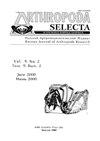Evidence and Modification of Non-Visual Eyestalk Organs in Troglobiont Mysida and Stygiomysida (Crustacea)
IF 0.7
4区 农林科学
Q4 ENTOMOLOGY
引用次数: 0
Abstract
Why do the eyes remain comparatively large, whereas the cornea is reduced in most troglobiont mysids? Are there any important organ size-dependent functions served by non-visual eye rudiments? This issue was approached by measuring eye structures in five troglobiont species of Mysida and two Stygiomysida compared with 14 troglophiles and 49 trogloxene Mysida species. The Organ of Bellonci (OB) was found in all Mysida and, as first records, also in Stygiomysida. The length of OBs increased with individual body length (BL) and eye length (EL) in four examined species: from postnauplioid larvae to adult stage in a troglophile and a trogloxene mysid species examined; and from juveniles to adults in a troglobiont mysid and a troglobiont stygiomysid. At the interspecific level, EL was, on average, 26% shorter at a given BL, while the OB was 40% longer at a given BL and 54% longer at a given EL, respectively, in adult troglobionts compared with trogloxene mysids. The OB is clearly proliferating, while the cornea is reduced in troglobionts. This points to sensory functions (possibly together with other functions). The sensory pore organ was found in all 15 Mysida species whose eyes were mounted on slides, and the first record of this organ was also found in Stygiomysida.穴居动物(甲壳纲)海鞘和海鞘非视觉眼柄器官的证据及修饰
为什么眼睛仍然相对较大,而大多数穴居动物的角膜却缩小了?非视觉眼的基本器官是否有重要的器官大小依赖的功能?通过对5种穴居动物米西达目和2种茎形米西达目与14种穴居动物和49种穴居动物米西达目的眼睛结构进行比较,探讨了这一问题。贝隆氏器官(OB)在所有米西达科动物中都有发现,作为最早的记录,也在海鞘科动物中发现。在4种被测物种中,眼珠的长度随个体体长(BL)和眼长(EL)的增加而增加:一种穴居动物和一种穴居动物的眼珠从nauploid后幼虫到成虫阶段;以及从幼年到成年的穴居动物mysid和穴居动物stygiomysid。在种间水平上,与穴居虫相比,成年穴居虫的EL在给定BL下平均缩短26%,OB在给定BL下平均延长40%,在给定EL下平均延长54%。OB明显增生,而角膜在穴居细胞中减少。这指向感觉功能(可能与其他功能一起)。在载玻片上的15种目蝇中均发现了感觉孔器官,并且在Stygiomysida中也发现了该器官的首次记录。
本文章由计算机程序翻译,如有差异,请以英文原文为准。
求助全文
约1分钟内获得全文
求助全文
来源期刊

Arthropoda Selecta
Agricultural and Biological Sciences-Insect Science
CiteScore
1.60
自引率
33.30%
发文量
44
期刊介绍:
The open-access, peer-reviewed journal is published mostly in English. The scope of the journal is the morphology, taxonomy, development, life histories, zoogeography, phylogeny and evolution of Crustacea, Chelicerata, Myriapoda and other arthropods, both recent and fossil.
 求助内容:
求助内容: 应助结果提醒方式:
应助结果提醒方式:


